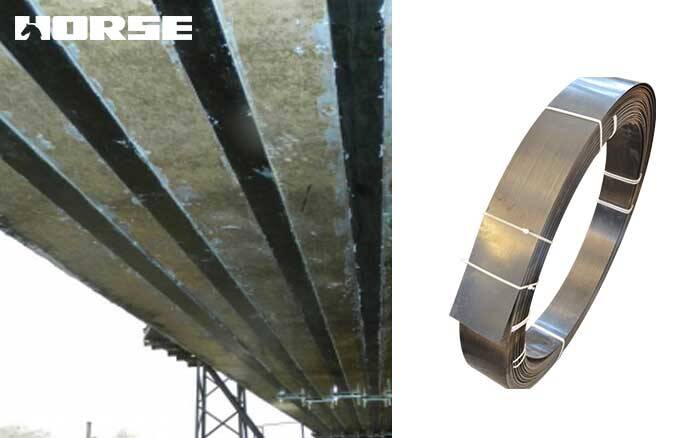Solutions
Horse Construction offers full range of structural strengthening materials with technical supports, documentation supports, products supports, project supports.
How To Use Carbon Fiber To Reinforce The Structure?

In response to the huge demand for carbon fiber laminate (CFRP) in structural reinforcement, we will provide some guidelines on how to use them correctly to control the design, application and final protection stages.
How to effectively use carbon fiber laminate to strengthen the structure.
During the design phase, the following controls must be implemented:
The carbon laminate should only be placed in the stressed area of the structure. Its arrangement in the compression surface will only cause the sheet to bend and separate, but will not provide any improvement.
A supply company with qualified technicians must be used to be able to request calculations or reports to justify the solution.
Supporting calculations must be performed, or written approval must be obtained from the company that manufactures the laminate. This calculation must include at least:
Enhanced object (the reason that inspired it and the data that started it),
Range (the element and area of the element to be strengthened),
Reinforce the ELU and/or ELS of the component,
Reinforcement arrangements,
Technical data sheet or application
The calculation must clearly indicate the purpose and scope of the reinforcement, and prove that no additional shearing or bending of the reinforcement is required in the same or adjacent elements.
It must be clearly indicated whether the reinforcement is sufficient to ensure that the deformation (flexion and cracking) of the element is below the limit set by the EHE, or only the "final" design strength is considered.
The maximum deformation used in laminates is 0.6% (adhesion), 0.8% (cut-in or end anchoring) and 1.2% (prestress). Even if the elastic deformation of the laminate is about 1.6%, the higher deformation has no meaning for the concrete panel.
Depending on the type of laminate used, its thickness and concrete strength, it is necessary to calculate the minimum carbon straight extension at both ends of the area to be reinforced. In the case of embedding, it is necessary to ensure the transmission of the internal load of the node.

In the application phase, the following controls must be implemented:
The company that implements the application must be trained and approved by the manufacturer or seller for material implementation.
The concrete support should last at least 3 weeks, the minimum surface tensile strength is 1.5 MPa, the humidity is less than 6%, and there will be openings and slight roughness (sandblasting, acid, diamond disk, etc.). Concrete burrs and voids will be checked.
It cannot be used at a temperature lower than 5ºC. At low temperatures, the load entry time increases significantly.
If necessary, a dry thixotropic epoxy mortar with a modulus of elasticity similar to that of concrete will be used for pre-repair. If hydraulic mortars are used, they will be of type R4 and have been coated on the epoxy primer.
The components to be reinforced will be free from overload or static load as much as possible, and telescopic struts can be used to retract the secondary shaft when necessary. After construction, the structure will remain unloaded for 48 hours and can be fully loaded in about 1 week.
Adhesive will be placed on the back of the sheet and on the support to avoid pockets clogged by air. When pressed with rigid rollers or metal profiles, the adhesive will be enough to make it overflow.
Before lamination, the backing of the laminate and the support must always be cleaned with a solvent, and never rinsed with water.
The laminate will be arranged symmetrically with respect to the axis of the elements and aligned longitudinally when overlapping
The hardened adhesive sheet will have a minimum thickness, always less than 3 mm.
In the final protection stage, the following control measures must be implemented:
For aesthetic reasons, external painting or coating is recommended.
Before laminating or finishing, the laminate must be lightly sanded and even lightly reinforced with an alkali-resistant glass veil.
CFRP should not be placed in a structure with a safety factor lower than 1. Fireproof board or mortar should be used for protection.
Laminates should not be drilled under any circumstances, because it will make the width of the board equal to the drilled diameter.
If it is used on the floor, it must be covered later for protection and can be applied immediately with the same adhesive used. In the case of heavy objects, it will sink 2-3 mm into the sidewalk and be flush with the epoxy resin.
You can find anything here you are in need of, have a trust trying on these products, you will find the big difference after that.

High strength, unidirectional carbon fiber wrap pre-saturated to form a carbon fiber reinforced polymer (CFRP) wrap used to strengthen structural concrete elements.

High strength, unidirectional carbon fiber sheet pre-saturated to form a carbon fiber reinforced polymer (CFRP) sheet used to strengthen structural concrete elements.

High strength carbon fiber reinforced polymer(CFRP) plate for structural strengthening and concrete repair